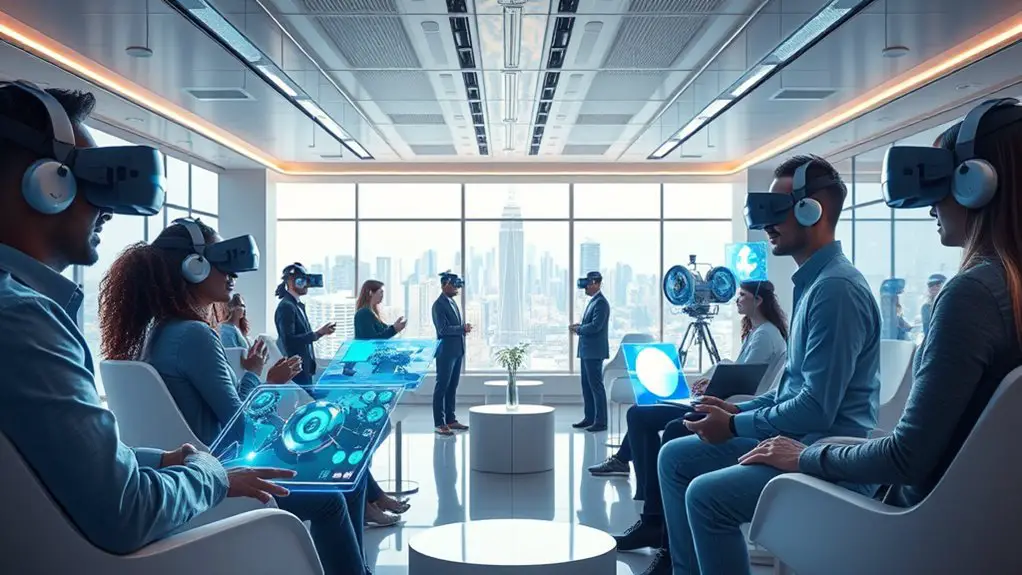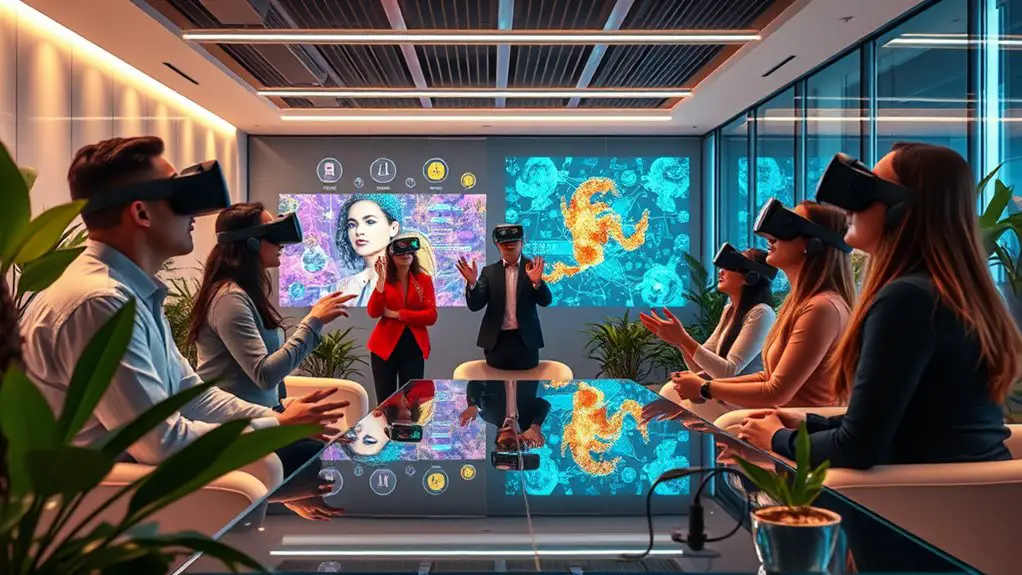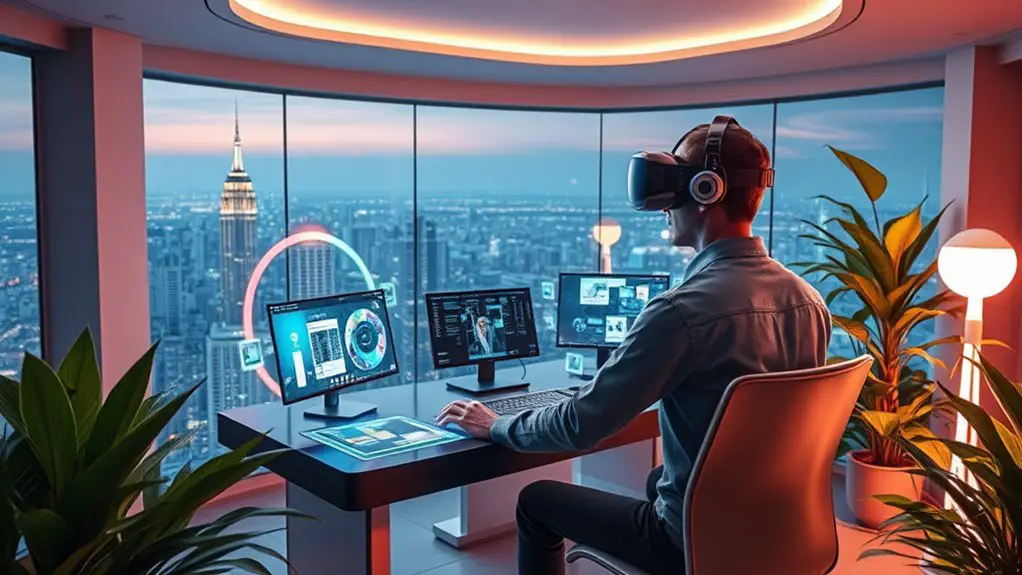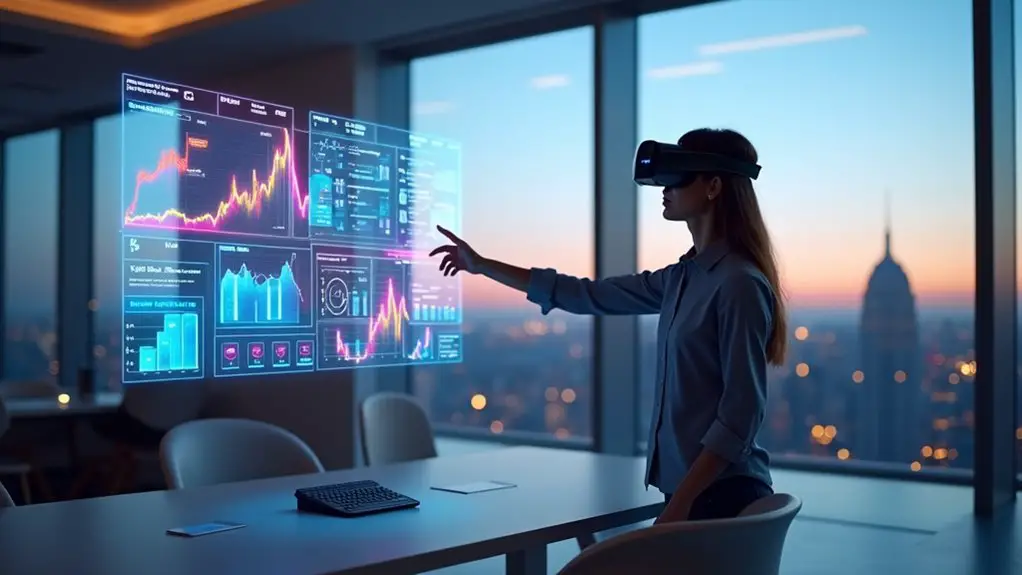The rise of virtual reality workspaces is transforming collaboration by creating immersive environments tailored to your team's needs. You'll experience enhanced communication and creativity, pushing the boundaries of traditional office layouts. While challenges like costs and employee adaptation exist, VR's potential to boost innovation is immense. Expect personalized tools, smart integrations, and a more engaging work atmosphere to become the norm. Keep exploring to discover what these changes could mean for your future work experience.
Key Takeaways
- Virtual reality workspaces will enhance team collaboration through immersive environments, simulating real-world interactions regardless of physical location.
- As technology advances, personalized virtual environments will cater to individual productivity styles, fostering a more efficient work atmosphere.
- The integration of AI will provide smart suggestions and automate tasks, streamlining workflows in virtual settings.
- Gamification elements will emerge, making work more engaging and motivating while encouraging creativity and innovation.
- The affordability of VR hardware will increase, leading to broader adoption across various industries and smaller businesses.
Understanding Virtual Reality Workspaces

As you explore the concept of virtual reality workspaces, you'll find they offer immersive environments that transform how we collaborate and interact.
These spaces simulate real-world settings, allowing you to engage with colleagues as if you're all in the same room, regardless of physical distance.
Virtual reality workspaces create immersive environments, making remote collaboration feel like you're all together in one room.
You can customize your virtual environment to match your team's needs, whether it's a sleek modern office or a serene outdoor setting.
The technology uses headsets and motion tracking, enabling you to interact with digital objects and share documents seamlessly.
You'll also discover that VR workspaces can enhance creativity, as they remove the limitations of traditional office layouts.
Benefits of Immersive Collaboration
When you embrace immersive collaboration in virtual reality workspaces, you'll notice a boost in team communication.
This technology breaks down barriers, allowing everyone to engage more effectively and share ideas freely.
As a result, you'll likely see increased productivity levels across your projects.
Enhanced Team Communication
While traditional communication methods often lead to misunderstandings, immersive collaboration in virtual reality workspaces transforms how teams connect.
With VR, you can engage in real-time conversations, feeling as if you're in the same room, regardless of physical distance. This shared environment fosters a deeper understanding, allowing you to pick up on non-verbal cues that text or video calls can't convey.
You can brainstorm ideas, visualize projects, and solve problems together, all within an interactive space.
Plus, VR can break down language barriers through intuitive visual aids and simulations.
By using immersive collaboration, you'll enhance your team's communication, leading to stronger relationships and a more cohesive work environment.
Embrace this technology and watch your interactions evolve.
Increased Productivity Levels
Immersive collaboration in virtual reality workspaces considerably boosts productivity levels. When you're fully engaged in a virtual environment, distractions fade away, allowing you to focus on tasks at hand.
You can easily share ideas, manipulate 3D models, and participate in real-time discussions, which enhances teamwork and accelerates decision-making. With VR, you can visualize complex data and concepts, making it simpler to grasp and tackle challenges together.
This hands-on approach not only fosters creativity but also streamlines workflows, saving you time and effort. Plus, the sense of presence in a virtual space can motivate you and your team, pushing everyone to achieve their best.
Embracing VR collaboration could be the key to releasing your full productivity potential.
Enhancing Creativity and Innovation

Creativity thrives in environments that stimulate the mind, and virtual reality workspaces are uniquely designed to do just that. In these immersive settings, you can break free from traditional constraints and explore ideas without limitations.
You'll find inspiration in vibrant 3D landscapes that enhance your thinking and encourage collaboration. With tools that allow for interactive brainstorming, you can visualize concepts in real-time, making it easier to innovate.
VR also fosters diverse perspectives by connecting you with colleagues worldwide, sparking fresh ideas and approaches. As you engage with dynamic environments, you'll discover that creativity flourishes when you feel free to experiment and play.
Embracing VR in your workspace could lead to breakthroughs you never thought possible.
Challenges of Implementing VR in the Workplace
Although the potential benefits of virtual reality in the workplace are enticing, several challenges can hinder its effective implementation.
First, the cost of VR technology can be prohibitive, especially for small businesses. You'll also face a steep learning curve; employees may struggle to adapt to new systems and tools.
Additionally, creating engaging and relevant VR content requires skilled developers, which can be difficult to find.
There's also the concern of employee discomfort or motion sickness, which could impact productivity.
Finally, integrating VR with existing workflows and ensuring data security can be complex.
Addressing these challenges is essential if you want to fully leverage the advantages VR workspaces can offer.
Future Trends in Virtual Reality Workspaces

As businesses tackle the challenges of implementing VR technology, they're also setting the stage for exciting future trends.
You'll see enhanced collaboration tools that'll allow teams to interact in real-time, regardless of location. Expect personalized virtual environments tailored to individual productivity styles, making work feel more engaging.
Integration with AI will streamline tasks, providing smart suggestions and automating routine activities. Also, the rise of gamification in VR workspaces will make daily tasks more enjoyable and motivate you to achieve your goals.
Finally, as VR hardware becomes more affordable, expect wider adoption across various industries, leading to a more immersive and connected workplace experience.
Embracing these trends can help you stay ahead in a rapidly evolving digital landscape.
Preparing for the Shift to VR Collaboration
To thrive in the new era of VR collaboration, you'll need to embrace a few key strategies.
First, invest in the right VR tools that suit your team's needs. Familiarize yourself with the software and hardware, as comfort with technology will enhance productivity.
Next, encourage open communication and adaptability among your team members; they'll need to share ideas seamlessly in this new environment. Schedule regular training sessions to help everyone build confidence in using VR platforms.
It's also crucial to establish clear guidelines for collaboration to guarantee efficiency.
Finally, foster a culture of creativity and innovation, allowing your team to explore the full potential of VR. By preparing effectively, you'll set the stage for a successful shift into this exciting workspace.
Frequently Asked Questions
How Much Does Setting up a VR Workspace Typically Cost?
Setting up a VR workspace typically costs between $1,000 to $5,000, depending on the hardware, software, and additional accessories you choose. It's worth researching options to find what best fits your needs and budget.
What Hardware Is Necessary for Effective VR Collaboration?
To effectively collaborate in VR, you'll need a powerful headset, motion controllers, and a compatible PC or console. High-quality audio equipment enhances communication, while a stable internet connection guarantees smooth interactions with your team.
Can VR Workspaces Be Integrated With Existing Software Tools?
Yes, VR workspaces can integrate with existing software tools, enhancing your workflow. You'll find compatibility with popular platforms, allowing seamless collaboration and communication, making your virtual environment more efficient and user-friendly for everyone involved.
What Industries Are Adopting VR Workspaces the Fastest?
You'll find industries like gaming, real estate, and healthcare adopting VR workspaces the fastest. They're leveraging immersive experiences to enhance collaboration, training, and client interactions, pushing boundaries and transforming how they operate in a digital landscape.
Are There Any Health Risks Associated With Prolonged VR Use?
Yes, there are health risks with prolonged VR use. You might experience eye strain, headaches, or motion sickness. To minimize these effects, take regular breaks and adjust your headset for comfort and clarity.
